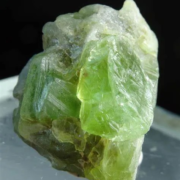Peridot Stone – Properties, Virtues & Benefits
Peridot stone, also known as olivine, is a green gemstone that symbolizes growth, prosperity and protection. Discover its characteristics, properties and uses in this article.
PERIDOT CHARACTERISTICS
- Chakra: Heart.
- Properties: Protection, growth, prosperity, harmony.
- Astrology: Mercury.
- Zodiac: Leo, Virgo, Libra, ScorPio, Sagittarius.
- Elements: Earth, Fire.
- Colors: Olive green, Yellow green.
- Hardness: 6.5-7 on the Mohs scale.
- Chemical Formula: (Mg, Fe)2SiO4.
- Associated god: None.
PÉRIDOT – HIS HISTORY
Peridot, a remarkable gemstone, has an origin dating back to around 1500 B.C. It is associated with ancient Egypt and has attracted the interest of historians because of its place in Egyptian culture. Some historians often confuse peridot with Cleopatra’s famous emerald jewels, assuming that they were in fact adorned with peridot stones. The stone was originally misnamed topaz, but the topaz we know today has since reclaimed its identity. The Egyptians called peridot “stone of the Sun” and believed it belonged to the mystical world. Its fascinating brilliance was often associated with light, making it easy to explore at night to mark its location before miners extracted it in the daytime. The stone was also known in Greek jewelry and was mainly owned by Ottoman sultans. Pharaonic soldiers guarded it preciously and executed anyone who tried to take it by force.
Diamond and peridot are exceptional stones because they are created deep in the earth’s mantle, unlike other crystals formed in the earth’s crust. They are brought to the surface by the movement of tectonic plates and volcanic activity, only to be discovered by man. Peridot was mainly discovered on the island of Topazos, known today as Zabargad or St. John’s, in the heart of the Red Sea. This stone has a special history, described in Pliny the Elder’s book of natural history, which dates it back to the 4th century BC. The Zabargad region has been searching for the presence of the stone for over 3,500 years.
Peridot is present in many cultures, symbolizing the tears of the Hawaiian goddess Pele. It was also used to decorate churches after the Crusades, such as the large peridot on the shrine of the Magi in Cologne Cathedral. Stone mining on the island of Zabargad ended after the Second World War, and five dominant deposits are now found in Burma, Pakistan, the USA (Arizona and New Mexico), China and Vietnam.
.
Peridots larger than 8 carats are held by collectors or museums. The finest assortments of peridots are on display in American museums in New York and Chicago. Washington’s Smithsonian Institute also owns a precious 310-carat mineral.
PÉRIDOT – ITS ORIGIN AND COMPOSITION
It’s not clear where the name peridot comes from, but it’s thought that it might derive from the Arabic word “faridat”, meaning gemstone and pearl, or from the Latin word “paederos”, derived from Greek, meaning an amethyst or opal. Pliny the Elder describes this stone as green and transparent, with a captivating beauty that deserves its name. Peridot is an exceptional combination of magnesium, iron and silica that creates a stunning green jewel thanks to the presence of nickel or chromium.
.
Its color, similar to the greenish hue of emerald, explains why it’s often referred to as “evening” or “poor man’s” emerald. Peridot is also described under the names chrysolite and olivine. Palladot is a rare variety of this precious mineral and is a type of meteorite of variable size that contains inclusions of olivine crystals and a shiny layer of a chemical mixture of iron and nickel. Celestial peridots are found at the heart of these meteorites and are one of the rare extraterrestrial stones that fall to earth in the form of shooting stars.
The rarity and beauty of these idiochromatic stones make them a popular adornment for jewelry, offering a range of fabulous colors from light olive to the most intense.

PERIDOT STONE – VERTIES AND PROPERTIES
PSYCHOLOGICAL PERIDOT
Peridot has positive mental effects on the wearer, improving self-confidence by reducing stress and erasing any guilt inherited from the past. This gemstone is also important in sPirituality because of the energy it contains. It is attributed mystical powers to forget melancholy and various ailments, but it also brings good fortune and felicity to its owner.
Many popular beliefs are associated with peridot, including protection from the terrors of the night, the reversal of an evil spell, the alleviation of excess body heat or coughing problems, the success of marriages and relationships, and the ability to ward off evil sPirits. For magic to work, the stone must be worn on the wrist, held under the tongue to activate its chemical virtues, or placed on gold. Peridot offers clairvoyance and purity to its wearer by touching extrasensory points such as the third eye. It is also effective in helPing people overcome disorders of excessive fear and low morale. By wearing this stone, resentment, nervousness and jealousy disappear. Peridot dispels heartache and darkness to make way for the green light of beauty and purity it releases.
PHYSICAL PERIDOT
Peridot has a beneficial effect on the skin by reaching the heart and solar plexus chakras, where vital energy is concentrated, to eliminate toxins and give the body vitality and tone. When placed on a painful area of the abdomen, it regulates the liver, intestines or gallbladder, and if held against the body, it can eliminate blood circulation problems.
.
Peridot can also be dissolved in water to help treat certain skin disorders. It is also useful for weight loss, as it helps eliminate fat through successive massages and encourages self-acceptance by assuming curves. Women in childbirth can also use this stone to activate contractions and ease pain. Peridot also provides renewed energy and optimal health, while acting on the heart, blood circulation and promoting quality sleep.
Peridot can be useful for various tissue irritations and to soothe the pain of insect bites and various skin problems. It aids digestion and improves intestinal transit, making it possible to enjoy a cheerful new day. Finally, it’s interesting to note that olivine, a more affordable gemstone than peridot, offers the same benefits.
Peridot is a gemstone of astonishing beauty, as is the history and origin surrounding it. This stone is found on the island of Zabargad, on the Egyptian side of the Red Sea, and is characterized by a wide range of colors from yellow-green to the darkest. To purify it, simply immerse it in salted distilled water and expose it to the sun on a quartz cluster for it to recharge in energy and act effectively on body and mind.
Peridot is widely used in lithotherapy, as it is renowned for its many physical and psychological benefits. By alleviating ailments of the heart and mind, it enables optimal self-esteem and health for a long, happy life. This stone will never leave you once you’ve experienced its benefits for the whole body, as the health of the mind is often overlooked. Its story deserves to be known and shared to ensure its mystical value endures.

PÉRIDOT – CLEANING AND REFILLING
To clean and recharge the Peridot stone, here are some methods you can use:
Cleaning:
- Rinse the stone with clear, soapy water, then dry with a soft cloth.
- Place the stone in a bowl of salted distilled water for a few hours, then rinse with clear water and dry.
- Gently rub the stone with a cloth soaked in rubbing alcohol.
Loading:
- Expose the stone to the sun for a few hours.
- Place the stone on a cluster of crystals such as amethyst or quartz.
- Use the visualization technique by holding the stone in your hand and imagining pure white light recharging it with positive energy.
It is recommended to clean and recharge your Peridot stone regularly to maintain its optimal energetic properties.
WHERE DOES THE NAME PERIDOT COME FROM?
The name “peridot” comes from the French word “ de l’île” (olivine stone), which refers to Zabargad Island (also called St. John’s Island) in the Red Sea, where the ancient Egyptians have mined this stone since antiquity. The term “peridot” was later adopted in English from the French word “peridot”. Peridot stone is also known as olivine in reference to its characteristic green color.
WHICH CHAKRA DOES THE PERIDOT ACT ON?
Peridot stone acts primarily on the heart chakra (4th chakra), promoting emotional balance, emotional healing and the release of emotional blockages. It can also stimulate the solar chakra (3rd chakra), boosting self-confidence, creativity and vitality. Peridot stone is often used in lithotherapy to open and harmonize the heart chakra, which is associated with love, compassion and inner peace.
WHICH ASTROLOGICAL SIGN IS ASSOCIATED WITH THE PERIDOT?
Peridot is associated with several astrological signs, including Leo, Virgo, Libra, ScorPio and Sagittarius. The Peridot stone is particularly beneficial for people born under these zodiac signs, as it is believed to strengthen the positive characteristics of their personality and mitigate the negative effects of their less favorable character traits.
PERIDOT STONE SUMMARY
Peridot stone is a green gemstone, often associated with the color of summer because of its bright, refreshing hue. It is composed of iron and magnesium silicate, and has been used in jewelry since ancient times. Peridot is believed to have healing and protective properties, and can help attract prosperity and good luck. It is also considered the birthstone of August and is often given as a gift to celebrate 16 years of marriage. Most peridot stones are mined in the USA, Egypt, Australia, Burma and China.



